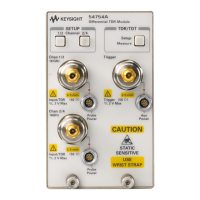Setup Channel Menu
User Calibrations
3-18
To view the temperature change
This procedure displays the temperature change that the instrument has
undergone since the last Plug-in Vertical Calibration.
1 Press the front-panel channel SETUP key.
2 Press
Calibrate
and then
Cal status on
.
The current plug-in ∆Temp value is listed for each installed module.
To perform a plug-in module vertical calibration
1 Remove any front-panel connections from channels.
2 Press Utility,
Calibrate. . .
, and then
Calibrate plug-in. . .
.
3 Select the plug-in module to be calibrated, press
1 and 2
or
3 and 4
.
4 Press
Start cal
to start the calibration.
5 Follow the on-screen instructions.
No additional equipment is required to perform a plug-in vertical calibration.
Reference signals are both generated and routed internally.
Probe Calibration
For active probes such as the HP 54701A, which the instrument can identify
through the probe power connector, the instrument automatically adjusts the
channel vertical scale factors to the probe’s nominal attenuation, even if a probe
calibration is not performed.
For passive probes or non-identified probes, the instrument adjusts the vertical
scale factors only if a probe calibration is performed. Probe calibration allows
the instrument to establish the gain and offset of specific probes that are
connected to a channel of the instrument, and then apply those factors to the
calibration of that channel.
The analyzer calibrates to the tip of the probe by setting the probe attenuation
to the actual attenuation ratio of the probe. The CAL signal is internally routed
to the probe tip for HP active probes.
The mainframe’s CAL signal is a voltage source, therefore you can let the
instrument compensate for the actual characteristics of your probe by letting
the instrument calibrate to the tip of the probe. The instrument automatically
calibrates to the tip of the probe, sets the probe attenuation, and compensates
for any probe offset.
If you do not perform a probe calibration but want to use a passive probe, enter
the attenuation factor using the following steps:

